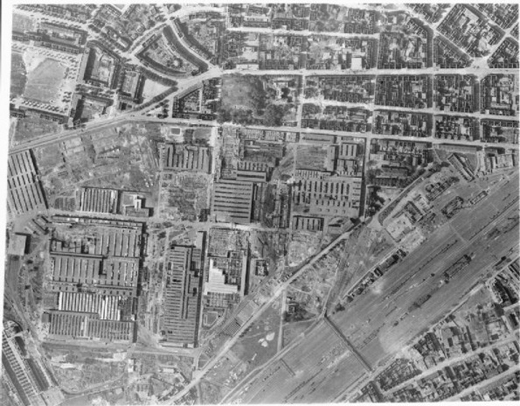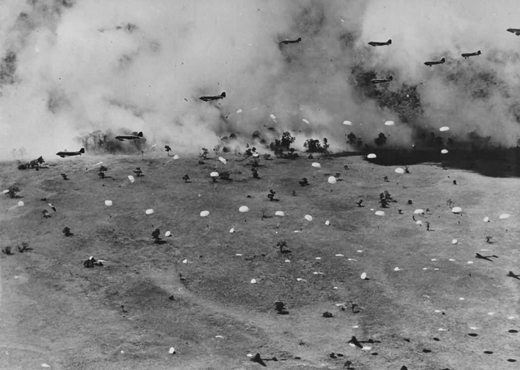Air Operation, CBI
FRENCH INDOCHINA- 15 14th Air Force P-38 and P-40 fighter-bombers attack a marshalling yard at Lao Kay, and 16 P-38s and P-40s attack a barracks near Lao Kay
Air Operation, Europe
RAF BOMBER COMMANDEvening Ops:
- 605 aircraft are ordered to carry out a double attack on Mannheim and Ludwigshafen. Included in the total are 299 Lancasters, 195 Halifaxes and 111 Stirlings.
- The target areas for this double attack is clear of cloud and the Pathfinder marking works perfectly. Ground markers are placed on the eastern side of Mannheim so that the main bombing force, coming in from the west, could move back across Mannheim and then into Ludwigshafen on the western bank of the Rhine. The 'creepback' is not excessive and severe damage is caused to both targets.
- 13 Halifaxes, 13 Lancasters and 8 Stirlings are lost.
- 4 Mosquitos are sent to Düsseldorf and 25 aircraft lay mines in the German Bight, near Texel and off Brest and Lorient.
- There are no losses.
Heavy Damage to Factory in Mannheim |
 |
BELGIUM:
63 Medium Bomb Wing B-26s attack a marshalling yard at Ghent about 0830 hours.
US 12th AIR FORCEITALY:
- Approximately 130 XII Bomber Command B-17s attack the Civitavecchia and Viterbo Airdrome.
- More than 200 XII Bomber Command B-25s and B-26s attack landing grounds around Grazzanise.
- 14th and 82nd Fighter Group P-38s down 3 Axis fighters over the Grazzanise area about 1300 hours.
Air Operation, New Guinea
Beginning at 1022 hours, in the first Allied operation of its kind in the Pacific Waróand immediately following low-level strafing and bombing attacks by 48 V Bomber Command B-25s and numerous V Fighter Command fighters, and the laying of a smoke screen by 7 3rd Light Bomb Group A-20só96 52nd Troop Carrier Wing C-47s out of airfields around Port Moresby drop the US 503d Parachute Infantry Regiment and an Australian Army airborne regiment directly on the Japanese base at Nadzab in the Markham Valley west of Lae. Gen Douglas A. MacArthur and a large contingent of his staff observe the parachute drop from 3 orbiting B-17s. Also, 5 43rd Heavy Bomb Group B-17s drop supplies to the paratroopers.
The airfield at Nadzab is quickly overrun and then immediately prepared for air operations so an entire Australian Army infantry division can be flown in to attack Lae from the flank. By 1840 hours, the site of the Nadzab dirt airstrip has been cleared of grass and debris so that it will be able to support landings by C-47s the next day. All in all, the Nadzab drop is brilliantly conceived and flawlessly executed. Escort and cover for the drop is provided by 146 V Fighter Command P-38s and P-47s.
24 V Bomber Command B-24s and 4 B-17s attack Japanese ground defenses between Lae and Nadzab. Taking advantage of their unopposed surprise landing, the paratroopers at Nadzab quickly link up with Australian Army ground forces in the Markham Valley.
[Air Operations, Sardinia
12th Air Force medium bombers and fighters attack Pabillonis and the radar station at Pula.
[Eastern Front
The main Soviet drives in the Bryansk and Donets sectors make considerable gains. The Russian 50th Army launches a 2-pronged outflanking operation east of Bryansk in an effort to encircle the Germans at Orel. Artemovsk in the south and Khutov and Mikhailovsky farther north are all in Soviet hands.
SOUTHERN SECTORThe 3rd Guards Army captures Artemovsk after a hard battle with the XXX Corps of the 1st Panzer Army.
[Italy
The forces for Operation AVALANCHE, the landing at Salerno, sail from North Africa for Italy.
[New Guinea
The US 503rd Parachute Regiment and a detachment of the Australian 2/4th Field Regiment, flown from Port Moresby in aircraft of the US 5th Air Force, land in the Markham Valley at Nadzab, northwest of Lae. A few hours later they are joined by Australian units (2/2nd Pioneer Battalion and the 2/6th Field Company) from Tsili Tsili. A companyof the Papuan Infantry Battalion (PIB), which has also moved forward, covers the western approaches to Nadzab. Work immediately starts on the construction of a landing strip for the Australian 7th Division, which is to be airborne. Nadzab airfield quickly becomes one of the main Allied air bases in the sector. During the night two more Australian brigades land on the coast east of Lae. The complete Australian 7th Division is to be flown in.
Paratroops Capture Lae Nadzab |
 |
Pacific
- The Japanese salvage vessel Yusho Maru (807t) is sunk by a mine in the Makassar Strait.
- The US submarine Swordfish (SS-193) sinks the Japanese army transport Tenkai Maru (3203t). [
Solomons
On Arundel Island, the 172nd Infantry, 43rd Division, unsuccessfully attacks the Japanese positions some 600 yards southeast of the base Bomboe Peninsula and strengthens their block at the base of the Stima Peninsula after enemy counterattacks there.
[Soviet Union, Home Front
As the German Army retreats, evidence of its atrocities are being uncovered. A report by a committee in Kharkov issued today reveals the fate of the city's Jewish population: 'The Commission opened up two pits near the village of Rogan in the valley of Drobitzki, one of the 100 meteres long and 18-20 meters wide, and the second 60 meters long and 20 meters wide. According to the findings of the Expert Medical Commission, upwards of 15,000 bodies were buried in these pits (attached: the report of the Medico-Legal Commission). Five hundred bodies were removed from the pits, of which 215 were submitted to medico-legal examination. They included the bodies of 83 men, 117 women and 60 children and infants. It was established that the cause of death of almost all these persons whose bodies had been examined was a wound and hole in the back of the skull caused by the passage of a bullet. This indicated that the shooting was carried out from behind the person to be killed and from a short distance away.'
[